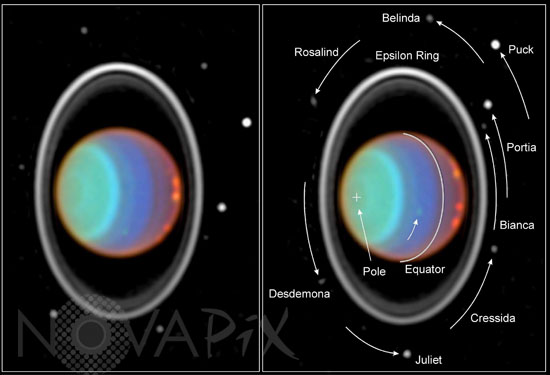Photo Agency - Astronomy - Space - Nature

Uranus with satellites seen by the Hubble space telescope
author: Nasa/Novapix
reference: a-ura02-00002
Image Size 300 DPI: 23 * 16 cm
The image on the right, taken 90 minutes after the left-hand image, shows the planet's rotation. Each image is a composite of three near-infrared images. They are called false-color images because the human eye cannot detect infrared light. Therefore, colors corresponding to visible light were assigned to the images. (The wavelengths for the "blue," "green," and "red" exposures are 1.1, 1.6, and 1.9 micrometers, respectively.)
At visible and near-infrared light, sunlight is reflected from hazes and clouds in the atmosphere of Uranus. However, at near-infrared light, absorption by gases in the Uranian atmosphere limits the view to different altitudes, causing intense contrasts and colors.
In these images, the blue exposure probes the deepest atmospheric levels. A blue color indicates clear atmospheric conditions, prevalent at mid-latitudes near the center of the disk. The green exposure is sensitive to absorption by methane gas, indicating a clear atmosphere; but in hazy atmospheric regions, the green color is seen because sunlight is reflected back before it is absorbed. The green color around the south pole (marked by "+") shows a strong local haze. The red exposure reveals absorption by hydrogen, the most abundant gas in the atmosphere of Uranus. Most sunlight shows patches of haze high in the atmosphere. A red color near the limb (edge) of the disk indicates the presence of a high-altitude haze. The purple color to the right of the equator also suggests haze high in the atmosphere with a clear atmosphere below.
The five clouds visible near the right limb rotated counterclockwise during the time between both images. They reach high into the atmosphere, as indicated by their red color. Features of such high contrast have never been seen before on Uranus. The clouds are almost as large as continents on Earth, such as Europe. Another cloud (which barely can be seen) rotated along the path shown by the black arrow. It is located at lower altitudes, as indicated by its green color.
The rings of Uranus are extremely faint in visible light but quite prominent in the near infrared. The brightest ring, the epsilon ring, has a variable width around its circumference. Its widest and thus brightest part is at the top in this image. Two fainter, inner rings are visible next to the epsilon ring.
Eight of the 10 small Uranian satellites, discovered by Voyager 2, can be seen in both images. Their sizes range from about 25 miles (40 kilometers) for Bianca to 100 miles (150 kilometers) for Puck.
At visible and near-infrared light, sunlight is reflected from hazes and clouds in the atmosphere of Uranus. However, at near-infrared light, absorption by gases in the Uranian atmosphere limits the view to different altitudes, causing intense contrasts and colors.
In these images, the blue exposure probes the deepest atmospheric levels. A blue color indicates clear atmospheric conditions, prevalent at mid-latitudes near the center of the disk. The green exposure is sensitive to absorption by methane gas, indicating a clear atmosphere; but in hazy atmospheric regions, the green color is seen because sunlight is reflected back before it is absorbed. The green color around the south pole (marked by "+") shows a strong local haze. The red exposure reveals absorption by hydrogen, the most abundant gas in the atmosphere of Uranus. Most sunlight shows patches of haze high in the atmosphere. A red color near the limb (edge) of the disk indicates the presence of a high-altitude haze. The purple color to the right of the equator also suggests haze high in the atmosphere with a clear atmosphere below.
The five clouds visible near the right limb rotated counterclockwise during the time between both images. They reach high into the atmosphere, as indicated by their red color. Features of such high contrast have never been seen before on Uranus. The clouds are almost as large as continents on Earth, such as Europe. Another cloud (which barely can be seen) rotated along the path shown by the black arrow. It is located at lower altitudes, as indicated by its green color.
The rings of Uranus are extremely faint in visible light but quite prominent in the near infrared. The brightest ring, the epsilon ring, has a variable width around its circumference. Its widest and thus brightest part is at the top in this image. Two fainter, inner rings are visible next to the epsilon ring.
Eight of the 10 small Uranian satellites, discovered by Voyager 2, can be seen in both images. Their sizes range from about 25 miles (40 kilometers) for Bianca to 100 miles (150 kilometers) for Puck.
Contact : Stéphane Aubin +33-(0)9-51-26-53-76
© Novapix - All rights reserved


